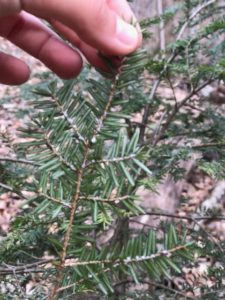The story was originally published in The Sylva Herald on Feb. 7, 2018.

A new front in the war against a destructive black and brown insect, the hemlock woolly adelgid, has been opened by Western Carolina University.
Research focused in Jackson and Macon counties started last fall, led by Peter Bates and Angela Mech from the Department of Geosciences and Natural Resources, along with Jim Costa from the Department of Biology.
A North Carolina Forest Services 2001-2010 report says that hemlock woolly adelgid “are a tiny aphid-like insect, originated in Asia and was detected in the eastern United States in the 1950’s.” In 10 years, 80 percent of hemlocks in the affected area of the Southern Appalachians have died due to the woolly agelgid infestation. They first appeared in North Carolina in 1995.
The WCU group is focusing on identifying potential sites where they can establish colonies of beetles that feed on the woolly adelgid, seeing if the beetles can grow naturally in this area after being introduced, and seeing if it is more efficient to release the adult beetles or let them let them reproduce and function independently.
The adelgid creates a thick white fuzzy patch on the needle base of hemlocks and can be widely seen in areas such as Pinnacle Park.
“I do not know the exact percentage, but only a very small fraction of hemlocks infected with adelgids have been able to survive on their own for more than several years,’’ said Bates. “Individual trees can be saved if treated with insecticides.”
According to the National Park Service, an Eastern Helmock can reach a height of 160 feet with a trunk diameter of six to seven feet. They may live to an age approaching 1,000 years.
The insects inject probes, call stylets into the tree limbs and feed from the base of the needles of native North Carolina hemlocks. The needles – and eventually the tree die – due to a lack of nutrients.
Hemlocks are essential in southern Appalachian forests. They provide shelter for streams so that they can maintain cool water temperatures, the United States Department of Agriculture says. Hemlock forests also provide homes for birds and other animals such as the red squirrels, bobcats and black bears, which are all commonly found in Western North Carolina.
The research remains in its early phase. Bates said only about half of the beetle eggs they grow in the lab make it to the adult phase, which has slowed the experiment. In the end, it’s hoped that Bates, Mech and Costa help find a biological solution to the extinction of hemlock trees in Western North Carolina.



